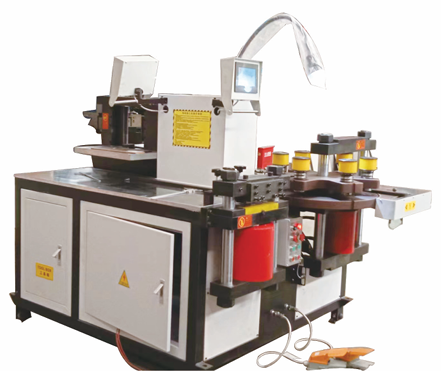Mastering Equipment Selection and Operation Tips to Increase Production Efficiency by 50%
As a core equipment in modern power equipment manufacturing, CNC busbar bending machines have become essential tools for manufacturing enterprises involved in high-low voltage switchgear, transformers, and new energy equipment. However, faced with a dazzling array of equipment models on the market, how to choose the most suitable CNC busbar bending machine for your production needs? How to avoid common problems in equipment use? These are practical challenges faced by many enterprise decision-makers and technical personnel. Today, we will deeply explore all aspects of CNC busbar bending machines to help you make the most informed choices.

CNC Busbar Bending Machine: More Than Just Bending Busbars
A CNC busbar bending machine is an intelligent equipment that precisely controls bending angles and positions through a CNC system, completely revolutionizing traditional manual bending operations. In modern power equipment manufacturing, it can quickly and accurately complete various complex shape bending processes, such as common right-angle bends, Z-bends, bevel bends, and even more complex multi-angle continuous bends. The core value of this equipment lies in its ability to ensure consistent bending accuracy for every product in mass production, which is crucial for subsequent assembly processes and can significantly improve overall production efficiency.
A high-performance CNC busbar bending machine typically consists of several key components: a high-rigidity frame structure, a precise hydraulic or servo drive system, an intelligent CNC operating system, and specially designed tooling systems. These components work together to ensure the equipment maintains high processing accuracy even during high-speed operation. Particularly, current equipment generally uses PLC control systems combined with touch screen operation, making equipment use simpler and more intuitive, allowing even novice operators to master basic operations in a short time.
Core Technology Analysis: Comprehensive Upgrade from Mechanical Structure to Intelligent Control
Host Structure Design is the foundation of equipment stability. Currently, mainstream CNC busbar bending machines use integrated steel plate welding structures, fully aged to effectively eliminate internal stress, ensuring the equipment doesn't deform during long-term use. The worktable part typically uses high-quality castings, precision-machined to ensure stability and accuracy during equipment operation. Some high-end models also adopt dual-machine linkage designs, where two worktables operate simultaneously to handle extra-long busbars, making this design particularly suitable for large power equipment manufacturing enterprises.
Transmission System directly determines the bending accuracy of the equipment. There are mainly two methods currently on the market: hydraulic drive and servo motor drive. Hydraulic drive offers advantages in greater power and relatively lower costs, suitable for processing thicker busbar materials; while servo motor drive provides higher accuracy, lower energy consumption, and faster response speeds, performing particularly better in applications requiring rapid positioning. Some high-end equipment has begun to adopt hybrid power systems, using hydraulic drive when high power is needed and servo drive for precise positioning, balancing efficiency and accuracy.
CNC System is the "brain" of the equipment and the part with the highest technological content. Modern CNC busbar bending machines generally use graphical operation interfaces—operators only need to input basic bending parameters, and the system automatically calculates the optimal bending solution. Advanced systems also feature automatic angle compensation, automatically adjusting bending angles according to material springback characteristics to ensure processing accuracy. More intelligent equipment even has self-diagnostic functions, monitoring equipment operating status in real time and providing timely alarms with solutions when abnormalities occur, greatly reducing equipment downtime.
Tooling System design is equally crucial. High-quality tools use special alloy steel manufacturing, undergoing special heat treatment processes for extremely high wear resistance and service life. The tool installation method is also specially designed, typically using quick-change structures that make tool changes more convenient and effectively reduce production preparation time. Some professional tool manufacturers also provide customized tool solutions according to customers' special needs, such as special-shaped tools specifically for processing special shapes.
How to Choose the Most Suitable Equipment Based on Enterprise Actual Conditions
First Consider Processing Material Characteristics. Different enterprises process various busbar materials and need to select equipment processing capacity according to material type, thickness, width, and other parameters. For example, the bending force required for copper bars and aluminum bars differs, with copper bars typically requiring greater bending force. Generally, equipment specifications should be slightly greater than current production needs, leaving some margin for future business development. For example, if currently mainly processing 8mm thick busbars, then choosing equipment that can handle 10-12mm busbars would be more appropriate.
Second, Evaluate Production Efficiency and Accuracy Requirements. If enterprises mainly engage in large-volume, standardized production, they should prioritize equipment with higher automation levels, such as equipped with automatic feeding systems, robotic arms, and other auxiliary equipment. For small-batch, multi-variety production modes, equipment flexibility and quick tool-changing functions become more important. In terms of accuracy, ordinary power accessory processing may not require high precision, but for high-precision switchgear manufacturing, bending accuracy often needs to be controlled within ±0.1 degrees.
Equipment Safety and Operability should not be overlooked. High-quality CNC busbar bending machines should be equipped with comprehensive safety protection devices, including photoelectric safety protection, two-hand operation buttons, emergency stop devices, etc. The operation interface should be intuitive and easy to understand, with simple program editing. Many current devices are equipped with 3D graphic display functions, visually displaying the bending process and results before processing, effectively avoiding scrap caused by programming errors.
After-Sales Service and Technical Support are important guarantees for ensuring long-term stable equipment operation. When selecting suppliers, focus on investigating their technical strength and service network. High-quality suppliers can not only provide timely after-sales responses but also professional technical training, regular equipment maintenance services, and adequate spare parts supply. These are all necessary conditions to ensure equipment always maintains optimal operating status.
Common Problems and Solutions in Equipment Use
Inaccurate Bending Angles is one of the most common problems. This is usually caused by inaccurate material thickness measurement, improper tool selection, or incorrect parameter settings. The solution is to use precise measuring tools to measure material thickness, select appropriate upper and lower tools, and correctly set bending parameters according to equipment instructions. If the problem persists, it may be necessary to check whether the equipment's mechanical components are worn or contact the equipment supplier for professional debugging.
Material Surface Damage is also a frequently encountered problem. This may be caused by foreign objects on the tool surface, unqualified tool quality, or excessive pressure settings. The solution is to regularly clean the tool surface, ensure the use of qualified tools, and reasonably adjust pressure parameters according to material characteristics. For products with particularly high surface requirements, consider using special protective films or protective tooling.
Abnormal Equipment Operating Noise often indicates mechanical failure. Common causes include insufficient lubrication, loose components, or mechanical wear. Operators should regularly maintain equipment, promptly add lubricating oil, and check the tightness of various components. If abnormal noise is found, immediately stop the machine for inspection, identify the cause and eliminate the fault to avoid greater losses.
System Alarms and Failures, although not frequent, require serious attention when they occur. Modern CNC equipment has comprehensive self-diagnostic functions—when a fault occurs, the system displays corresponding alarm codes. Operators can consult equipment manuals according to alarm codes or contact equipment supplier technical support personnel for professional guidance. Remember not to handle it without understanding the situation to avoid greater losses.
Key Points and Techniques for Equipment Maintenance
Daily Maintenance is the foundation for ensuring normal equipment operation. Operators should check whether all parts of the equipment are normal before work every day, whether the hydraulic oil level is within the standard range, and whether each lubrication point needs oiling. During work, pay attention to observing equipment operating status, and deal with abnormalities promptly. After each day's work, thoroughly clean the equipment, especially the tool and worktable areas, ensuring no metal chips remain.
Regular Maintenance can effectively extend equipment service life. Generally, after one month of equipment operation, a comprehensive inspection is needed, including checking hydraulic oil cleanliness, whether fasteners in various parts are loose, and whether electrical connections are reliable. After three months of operation, hydraulic oil and filters need replacement, and wear of key mechanical components needs checking. A major overhaul is best performed annually, with professional technicians conducting comprehensive testing and debugging of the equipment.
Hydraulic System Maintenance is particularly important. Regularly check hydraulic oil quality, promptly replacing oil if deterioration or contamination is found. Keeping the hydraulic system clean is crucial—when replacing hydraulic oil, ensure the oil tank and pipelines are clean. If equipment is unused for extended periods, regularly start the equipment and let the hydraulic system run for some time to ensure all components maintain good working condition.
CNC System Maintenance should not be overlooked. Keep the control cabinet clean and regularly check whether cooling fans work properly. Backing up system parameters is very important—it's best to regularly back up important system parameters and processing programs to external storage devices for quick recovery in case of system failure. When equipment needs long-term shutdown, regularly power on to prevent electronic components from dampness.
Future Development Trends: Intelligence and Green Manufacturing
Intelligence Levels are continuously improving. New generation CNC busbar bending machines have begun integrating IoT technology, able to collect equipment operating data in real time for remote monitoring and fault prediction. Some leading equipment manufacturers have also developed AI-based process parameter optimization systems that can automatically recommend optimal processing parameters according to material characteristics. These intelligent functions not only improve equipment ease of use but also greatly reduce technical requirements for operators.
Green Manufacturing Concepts are receiving increasing attention. Modern CNC busbar bending machines fully consider energy conservation and environmental protection requirements during the design phase, such as adopting high-efficiency energy-saving drive systems, optimizing hydraulic systems to reduce energy loss, and using environmentally friendly materials. Noise control during equipment operation has also significantly improved, with noise levels of some high-end equipment already controllable below 70 decibels, creating a better working environment for operators.
Flexible Manufacturing Capability is becoming a new competitive focus. To adapt to multi-variety, small-batch market demands, CNC busbar bending machines are developing towards greater flexibility. The addition of new functions like quick tool-changing technology, automatic programming technology, and offline simulation technology enables equipment to adapt faster to different product processing needs. This flexible manufacturing capability helps enterprises better respond to market changes and enhance market competitiveness.
When selecting a CNC busbar bending machine, don't just look at the price, but comprehensively consider equipment performance, reliability, after-sales service, and other comprehensive factors. It is recommended to personally test the machine at the equipment supplier before purchasing, conducting on-site inspections of equipment operating status and processing effects. Simultaneously, choose suppliers with strong technical strength and complete after-sales service to ensure equipment receives full technical support during subsequent use. Remember, good equipment is not only a production tool but also an important weapon for enterprises to enhance competitiveness.


